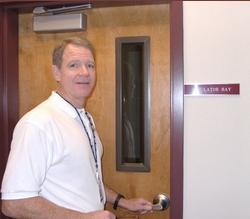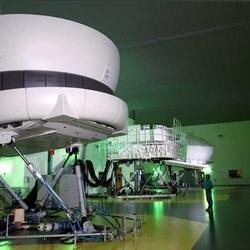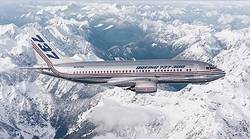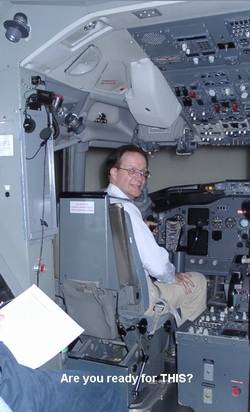Brave Souls Allow J-3 Flier to Experience a 737
By Tim Kern, ANN News Editor
 In March of this year, after profiling the (at the time)
nearly-rebuilt Lockheed Martin Commercial Flight Training Center in
Orlando (FL), I ended the article with, "Some day, I'm gonna fly
one of these things..." Well, I got my chance last week.
In March of this year, after profiling the (at the time)
nearly-rebuilt Lockheed Martin Commercial Flight Training Center in
Orlando (FL), I ended the article with, "Some day, I'm gonna fly
one of these things..." Well, I got my chance last week.
Bill Freeman, who is the center's new manager [Captain Ed
Slomka, featured in our last story, passed away late last Spring
--ed.], is a veteran of flight training, having held several
positions with similar responsibilities. Bill, who has significant
experience in the commercial and military training and simulation
industry, also maintains an Air Transport Pilot rating.
 After a tour of the now beautifully-finished
facility, Bill guided me to the simulator room, where three huge,
"real" flight simulators lurk in semi-darkness (right), standing on
their steel legs, waiting to convince one and all that they're
really airplanes.
After a tour of the now beautifully-finished
facility, Bill guided me to the simulator room, where three huge,
"real" flight simulators lurk in semi-darkness (right), standing on
their steel legs, waiting to convince one and all that they're
really airplanes.
Long history...
As we approached the 15-ton+ machines, he reminded me that
flight simulators have been around long enough to collect Social
Security. Early sims, like those that led to the popular Link
Trainer famous in WWII, had three-axis control, a panel with a few
"steam gauges," and a rudimentary control system. A 'jeep,' a
stub-wing 'airplane-on-a-stick,' with three-axis control that was
on a trailer, and towed by a car, gave students of inventor Al
Shatzel an open-air, eyes-off-the-instruments experience in the
1940s. To some good extent, they simulated the aircraft.
They look primitive, but they were useful training devices, and
became more-sophisticated as the needs of pilots, and the
capabilities of their aircraft, expanded.
By the late 1940s and through the 1950s, a live, visual
representation of terrain was available. This was achieved through
the use of a television system, that was controlled from the sim's
cockpit; the pilot watched a television tube, and saw what he was
flying over. The terrain was built into a huge (sometimes over 100
feet long) diorama, or "map board," which depicted, in detail, the
home airport and the environs. As the student flew over the
terrain, a camera covered the map board below. [Actually, these
were usually mounted on a wall, to save floor space --ed.]
 With
the refinement of motion systems, the in-cockpit experience became
more realistic; with the expansion of knowledge of the physiology
of flight, the sensations of motion became closer to the real
thing. By the early 1980s, the current generation of flight
simulators was ready for prime time. In the ensuing two decades,
sims' technology hasn't slowed. Better motion is coupled to better
sound, ventilation, and especially visual representations. The
current state of the art, as exemplified at Lockheed Martin's
facility in Orlando, has full-vision windows, wrap-around scenery,
and just about everything you can think of, to convince the student
that he's in a real airplane. One huge behind-the-scenes change has
taken place since the early 1980s: now, even these sims are driven
by PC-size computers.
With
the refinement of motion systems, the in-cockpit experience became
more realistic; with the expansion of knowledge of the physiology
of flight, the sensations of motion became closer to the real
thing. By the early 1980s, the current generation of flight
simulators was ready for prime time. In the ensuing two decades,
sims' technology hasn't slowed. Better motion is coupled to better
sound, ventilation, and especially visual representations. The
current state of the art, as exemplified at Lockheed Martin's
facility in Orlando, has full-vision windows, wrap-around scenery,
and just about everything you can think of, to convince the student
that he's in a real airplane. One huge behind-the-scenes change has
taken place since the early 1980s: now, even these sims are driven
by PC-size computers.
The Center
Since ANN's visit last March, the latest sim, the 737-800 Next
Generation has joined the 737-300 with EFIS, as the newest on-line
Level D sim in the facility. Bill Freeman (above) explained,
"Level D simulators can replicate everything the pilot could
experience, from push-back to shut-down. Every normal procedure,
every abnormal procedure..."
 Tech genius Mark Kaetzel [with Mr Freeman, right;
his actual title is Technical Operations Manager --ed.] recently
walked the B737-300 through its first FAA re-certification without
a single squawk. "We have over 100 abnormal and emergency events we
can throw at you," he said, "from a blown tire, to an engine
failure on takeoff, to all kinds of weather." (I just prayed for a
clear, calm flight, where all systems worked perfectly.)
Tech genius Mark Kaetzel [with Mr Freeman, right;
his actual title is Technical Operations Manager --ed.] recently
walked the B737-300 through its first FAA re-certification without
a single squawk. "We have over 100 abnormal and emergency events we
can throw at you," he said, "from a blown tire, to an engine
failure on takeoff, to all kinds of weather." (I just prayed for a
clear, calm flight, where all systems worked perfectly.)
The next sim to come fully on line will be an Airbus A320, which
will start flying on December 3. Students are already booked, for
that first week in December.
There's 50,000 square feet of training space available,
including a "parallel site" where three more Level D sims will find
homes, as market conditions dictate.
The Lockheed Martin facility currently caters mostly to airlines
based in the Americas. "Over 80% of the airlines have fewer
than 10 aircraft," Freeman told me. The Lockheed Martin
facility specializes in training for the airlines that simply can't
justify the cost of in-house simulators or large carriers who have
sim requirements that cannot be met in-house. "We run this center
24/7," he said. "When the market [for commercial pilot training]
does turn, it's going to turn quickly, and dramatically." Not only
will there be the usual transitional pilots to train; added to
their number will be a lot of today's furloughed pilots, getting
current again.
 He's ready for that. "Lockheed Martin is in the
commercial training business: our doors are open, and we're ready
to go."
He's ready for that. "Lockheed Martin is in the
commercial training business: our doors are open, and we're ready
to go."
That claim of "24/7" isn't idle, either. While most airlines run
less than half this much "up" time, the 737 NG sim recently logged
its first 20-hour day...
In addition to the sims themselves, too, are six classrooms, two
Flight Training Device rooms (where cockpit familiarization can be
practiced, thus keeping the sims "flying" more hours), and six
briefing rooms.
Why Orlando?
 "Orlando is the 'center of the universe' for
flight training and simulation," Freeman said. "The Governor [Jeb
Bush] calls it one of Florida's critical industries." Orlando is a
logical hub, too, as the technology of simulation converges with
the technology of full-immersion entertainment. Orlando is a great
place to train, too -- the roughly ten days most transition pilots
spend there, getting their ratings, give their families nearly
enough time to scope out the attractions within an hour and a
half's easy drive, from Cape Canaveral on the Atlantic coast to
Busch Gardens in Tampa, on the Gulf; and, of course, there are
major entertainment meccas right there in the Orlando area, too --
Disney World, Sea World, Universal Studios, the world's largest
McDonald's...
"Orlando is the 'center of the universe' for
flight training and simulation," Freeman said. "The Governor [Jeb
Bush] calls it one of Florida's critical industries." Orlando is a
logical hub, too, as the technology of simulation converges with
the technology of full-immersion entertainment. Orlando is a great
place to train, too -- the roughly ten days most transition pilots
spend there, getting their ratings, give their families nearly
enough time to scope out the attractions within an hour and a
half's easy drive, from Cape Canaveral on the Atlantic coast to
Busch Gardens in Tampa, on the Gulf; and, of course, there are
major entertainment meccas right there in the Orlando area, too --
Disney World, Sea World, Universal Studios, the world's largest
McDonald's...
Students
Lockheed Martin is looking ahead, when it comes to flight
training, too. "We're looking at how best to train pilots and
maintainers for the F-35 Joint Strike Fighter," said Mike
Mulleavey, manager of media relations. "The thing you need to
remember is, they're in fifth grade right now." For now, though,
there's quite a bit of transitional training for turboprop ATPs who
are going to start flying the 737s and A320.
Into the Sim
 OK -- I had had enough coffee, a tour, and some
background. It was time to climb the proverbial '13 steps' into the
simulator.
OK -- I had had enough coffee, a tour, and some
background. It was time to climb the proverbial '13 steps' into the
simulator.
The 737-300 (farthest from the camera; the A320 is in the
middle, and the 737-800 NG is in the foreground) was available, and
Mark Kaetzel had everything preflighted and ready to go. After
a short briefing, Freeman had me release the brakes for
push-back, from our gate at MIA (Miami, FL). Within about five
seconds, my brain thought we were in a real airplane, and I soon
wished I hadn't been up so late the night before. This was going to
be intense...
The 737 doesn't steer with the rudder pedals while on the
ground. Like most big ships, it's controlled with a little
half-steering-wheel, mounted on the left side of the cockpit wall,
in front of the pilot's left knee. This tiller can turn the
airliner pretty sharply, I soon found out, as we taxied to the
runway. Mercifully, Freeman, in the right seat, had picked up the
mic in his right hand (and taken a grip on the throttles with his
left), and was coordinating with Ground Control; and Mr. Kaetzel,
behind me, had cleared any traffic from within range of us.
 My
first impression was that this is a BIG airplane. [It's been seven
years since I've flown anything bigger than a 182; and the largest
airplane I've ever flown was a Hunting Pembroke, about 8000 pounds
empty, if memory serves --TK.] Furthermore, you're 'way out in
front of the yaw (and pitch) centers, so actions along those axes
are exaggerated in the cockpit. Add to that, the fact that there's
a lot of momentum inherent in any motion, and you might begin to
feel sympathy for my "passengers."
My
first impression was that this is a BIG airplane. [It's been seven
years since I've flown anything bigger than a 182; and the largest
airplane I've ever flown was a Hunting Pembroke, about 8000 pounds
empty, if memory serves --TK.] Furthermore, you're 'way out in
front of the yaw (and pitch) centers, so actions along those axes
are exaggerated in the cockpit. Add to that, the fact that there's
a lot of momentum inherent in any motion, and you might begin to
feel sympathy for my "passengers."
We lined up, and, since I have exactly zero jet experience,
Freeman wisely continued to run the throttles, as I did my best to
remember to steer, and to rotate at 130kts. By carefully running
the trim the wrong direction, and over-correcting wherever
possible, I managed to stay well behind the airplane, and pretty
much exhaust myself in short order. Within a few minutes, we were
heading back to the airport. Even with my co-pilot running
throttles, flaps, and gear, I was having trouble getting this
machine into position for landing. When I finally did, everything
was OK -- except I was going to land about 2/3 of the way down the
runway.
 The "missed approach" was handled in a wonderful
way: Mark simply set us up for another approach, a little farther
out, and set the autopilot. I knew that, barring those "abnormal
conditions," I'd best let 'George' fly the machine as far in as my
pride would allow; and by this time, my pride allowed George plenty
of PIC time. Thus, the landing wasn't bad, even when Mark
introduced a mild puff of a breeze, which he kindly termed,
"turbulence," near the end of the approach.
The "missed approach" was handled in a wonderful
way: Mark simply set us up for another approach, a little farther
out, and set the autopilot. I knew that, barring those "abnormal
conditions," I'd best let 'George' fly the machine as far in as my
pride would allow; and by this time, my pride allowed George plenty
of PIC time. Thus, the landing wasn't bad, even when Mark
introduced a mild puff of a breeze, which he kindly termed,
"turbulence," near the end of the approach.
But, for real pilots...
For those who already know how to fly airplanes that weigh more
than their cars, it was easy to tell that the experience is
unparalleled. Even in the short flight I took, my airmanship, such
as it was, ramped up; and it was obvious (at least to me) that, in
a relatively short time, I could improve to a less-embarrassing
level.
Obviously, this isn't a primary trainer; it isn't supposed to
be. For those who fit the profile, it's a better way to learn than
in the real cockpit: any combination of abnormal events can be
practiced, in any combination; replays and reviews are available;
time-consuming, routine tasks can be minimized or eliminated; and
your passengers won't write nasty letters to management.
 Airborne 04.16.24: RV Update, Affordable Flying Expo, Diamond Lil
Airborne 04.16.24: RV Update, Affordable Flying Expo, Diamond Lil ANN's Daily Aero-Term (04.20.24): Light Gun
ANN's Daily Aero-Term (04.20.24): Light Gun Aero-News: Quote of the Day (04.20.24)
Aero-News: Quote of the Day (04.20.24) Aero-News: Quote of the Day (04.21.24)
Aero-News: Quote of the Day (04.21.24) ANN's Daily Aero-Term (04.21.24): Aircraft Conflict
ANN's Daily Aero-Term (04.21.24): Aircraft Conflict










